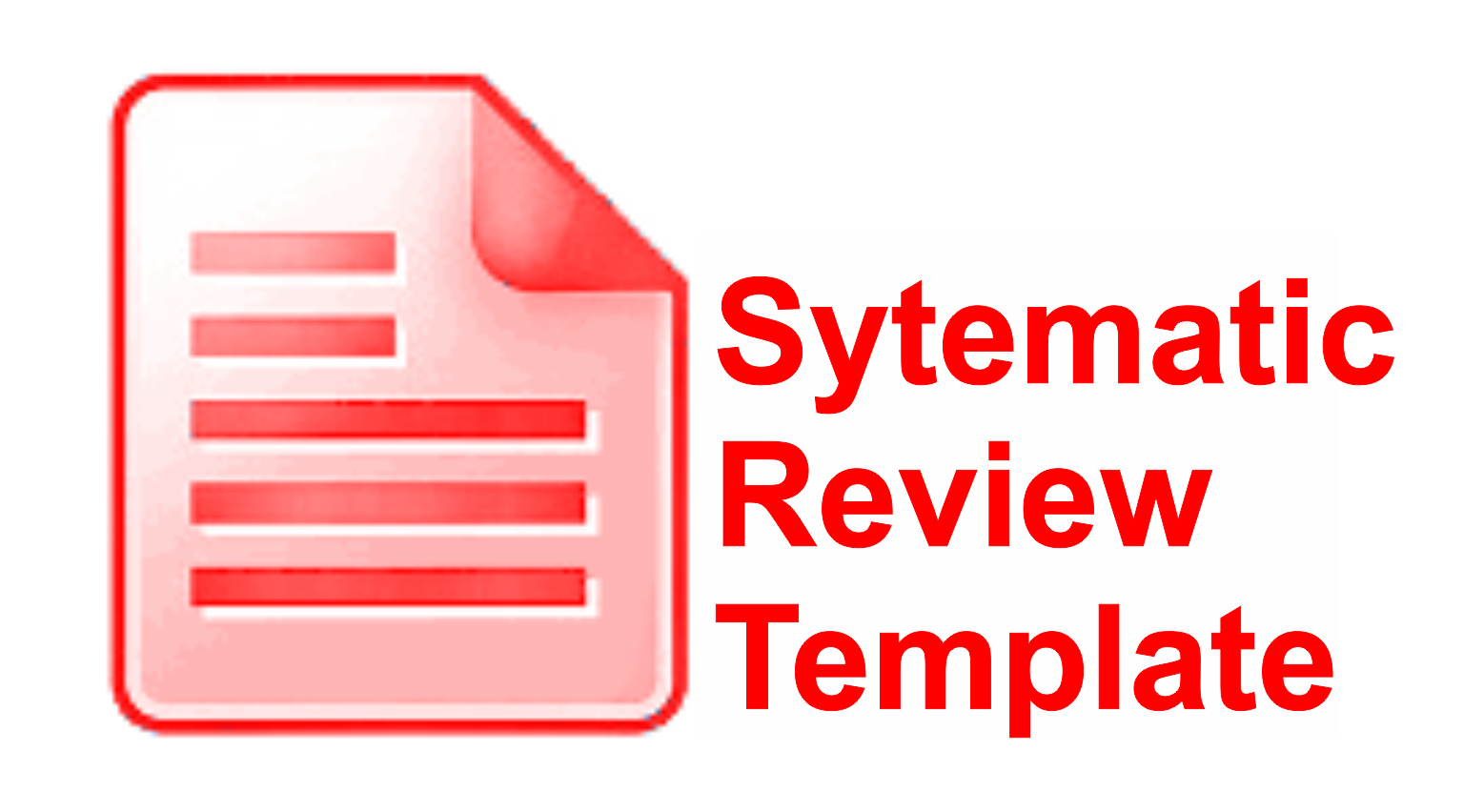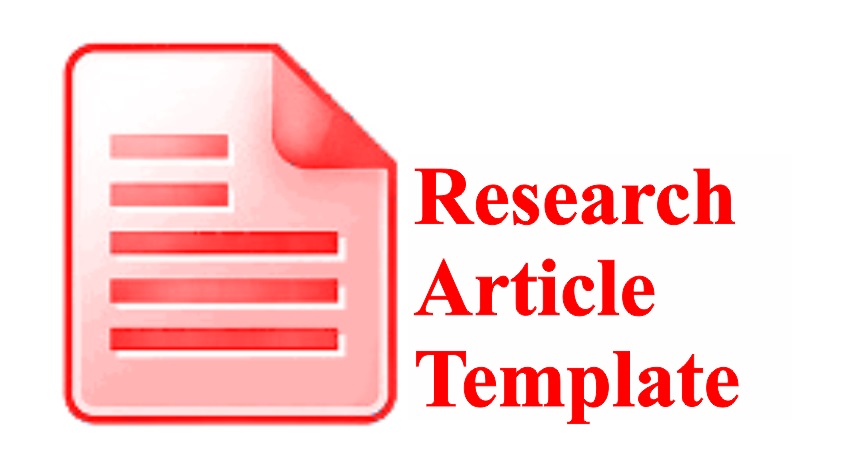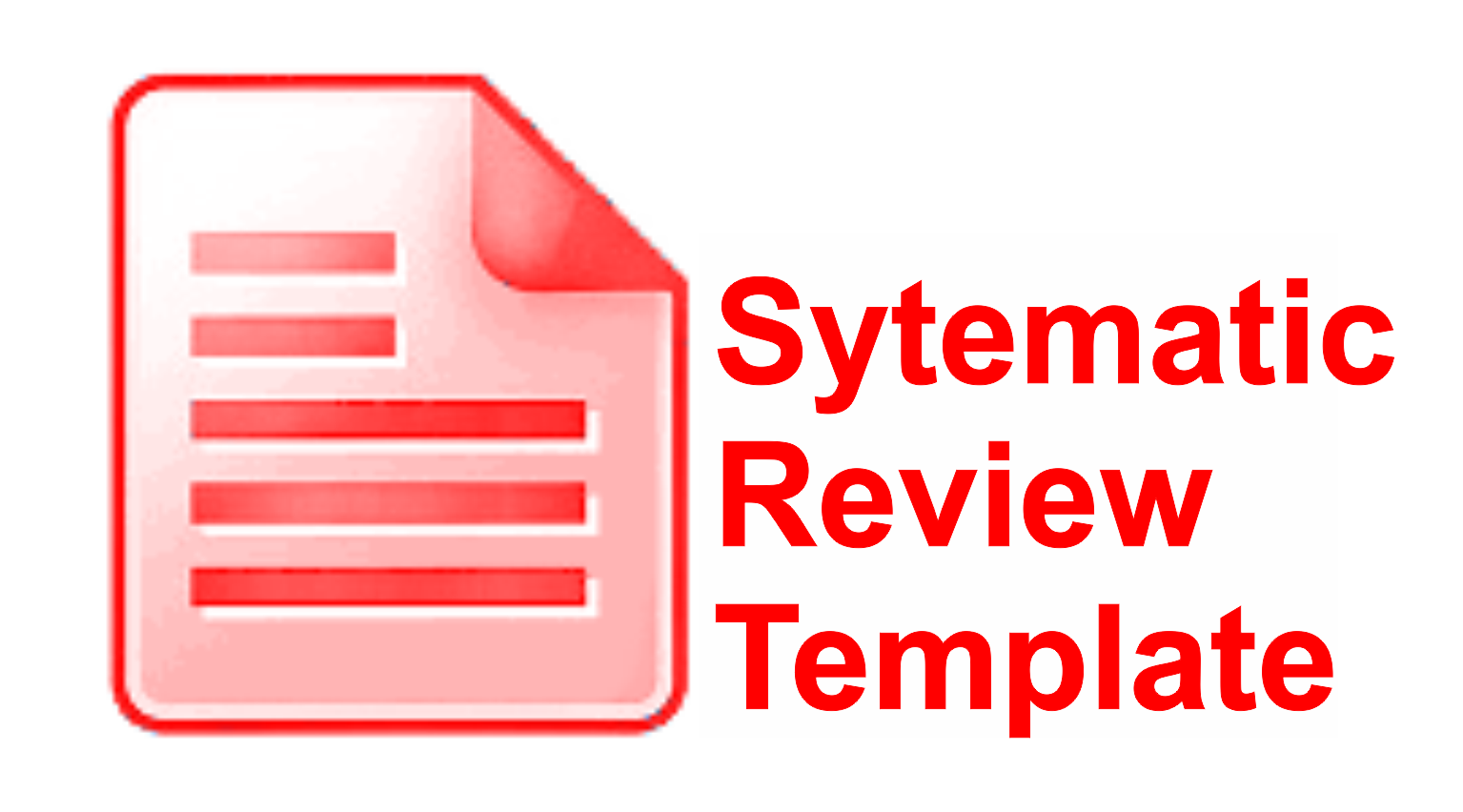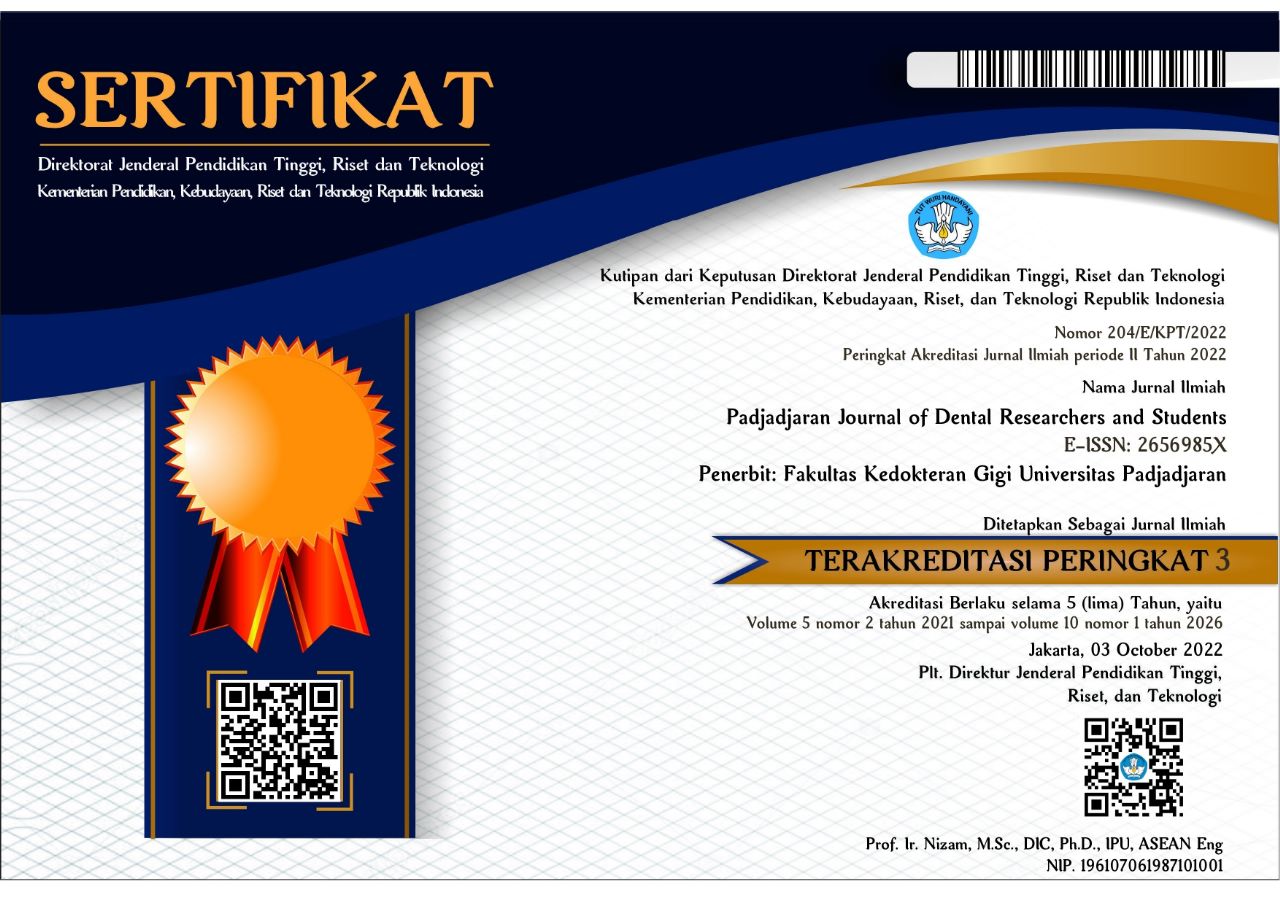Nilai facial index berdasarkan klasifikasi maloklusi angle pada sub ras deuteromelayu
Facial index value based on angle’s classification of malocclusion on deuteromalay subrace
Abstract
ABSTRAK
Pendahuluan: Perawatan ortodonti bertujuan untuk mencapai oklusi yang ideal dengan konfigurasi wajah yang harmonis. Proporsi ideal wajah pada masyarakat suatu daerah harus diketahui untuk digunakan sebagai sumber data dalam menegakkan diagnosis dan membuat rencana perawatan yang tepat agar perawatan ortodonti memperoleh hasil terbaik. Tujuan penelitian ini adalah mengukur nilai facial index berdasarkan klasifikasi maloklusi Angle pada Sub ras Deuteromelayu. Metode: Penelitian ini bersifat deskriptif dengan pendekatan cross sectional. Populasi penelitian yaitu mahasiswa Program Studi Sarjana Fakultas Kedokteran Gigi Universitas Padjadjaran sub ras Deuteromelayu. Metode pengambilan sampel yaitu total sampling dengan kriteria inklusi sampel berasal dari keturunan Suku Aceh, Suku Minangkabau, Suku Sunda, Suku Jawa, Suku Bali, Suku Bugis, dan Suku Makassar. Nilai facial index dihitung dari tinggi wajah dibagi lebar wajah lalu dikali 100. Hasil: Jumlah sampel total 115 orang, terdiri dari 17 pria dan 98 wanita. Data nilai facial index berdasarkan klasifikasi maloklusi Angle pada penelitian ini untuk pria terdapat 6 sub kelas maloklusi dengan 4 tipe wajah yang berbeda, sementara untuk wanita terdapat 6 sub kelas maloklusi dengan 5 tipe wajah yang berbeda. Klasifikasi Maloklusi Angle yang terbanyak pada pria dan wanita yaitu Kelas I Tipe 1 dan tipe wajah terbanyak yaitu mesoprosopic pada pria dan euryprosopic pada wanita. Rerata nilai facial index pada pria adalah 87,28 dan wanita adalah 84,16. Simpulan: Nilai facial index berdasarkan klasifikasi maloklusi Angle pada sub ras Deuteromelayu yang terbanyak pada pria yaitu Kelas I Tipe 1 dengan tipe wajah mesoprosopic dan leptoprosopic, dan pada wanita Kelas I Tipe 1 dengan tipe wajah euryprosopic.
Kata kunci: Maloklusi; Nilai facial index; Sub Ras Deuteromelayu
ABSTRACT
Introduction: Orthodontic treatment aims to achieve an ideal occlusion and a harmonious facial configuration. The ideal proportion of face in various area must be known for a data source in establishing a diagnosis and making the right treatment plan so that the orthodontic treatment achieves the best results. This study aimed to measure facial index based on Angle’s classification of malocclusion on Deuteromalay Subrace. Method: This research was a descriptive study with cross sectional approached. The research population were undergraduate students of Faculty of Dentistry, Padjadjaran University, Deuteromalay Subrace. The sampling method was total sampling with the inclusion criteria of samples were the descendants of the Acehnese, Minangkabau, Sundanese, Javanese, Balinese, Bugis, and Makassar ethnic groups. The facial index value was calculated from the height of the face divided by the width and then multiplied by 100. Results: The total sample was 115 people consisting of 17 men and 98 women. The facial index value data based on Angle’s classification of malocclusion in this study for men was 6 malocclusion subclasses with 4 different facial types, for women was 6 malocclusion subclasses with 5 different facial types. The most Angle’s classification of malocclusion in men and women were class I type 1 and the most facial types were mesoprosopic in men and euryprosopic in women. The average facial index in men was 87.28 and women was 84.16. Conclusions: The most facial type in men was mesoprosopic and euryprosopic in women, the most Angle’s classification of malocclusion was Class I Type 1.
Keywords: Malocclussion; Facial Index; Deuteromayal subrace
Keywords
Full Text:
PDFReferences
DAFTAR PUSTAKA
Yesmin T, Thwin SS, Afrin Urmi S, Wai MM, Zaini PF, Azwan K. A study of facial index among malay population. J Anthropol. 2014; 2014: 1–4. DOI: 10.1155/2014/726974
Saini V, Meena KR. Anthropometric comparison of facial parameters between male and female of rajasthan. Int J Heal Sci Res. 2017; 7(9): 96–9.
Ranjana G, Rohini M, Manik C. Anthropometric assessment of morphological facial index of gond males and females of uttar bastar kanker, c.g. Int J Anat Res. 2016; 4(4): 3170–4. DOI: 10.16965/ijar.2016.431
Kataria DS, Ranjan RK, Perwaiz SA. Study of variation in total facial index of north indian population. Int J Heal Sci Res. 2015; 5(4): 122–7.
Amin AA, Jamal Z, Noori AJ. Study of facial index among kurdish population. Int J Dent Res Dev. 2016; 6(4): 9-14.
Yu X, Liu B, Pei Y, Xu T. Evaluation of facial attractiveness for patients with malocclusion a machine-learning technique employing procrustes. EH Angle Educ Res Found Inc. 2014; 84(3): 410-16. DOI: 10.2319/071513-516.1.
Nunes H, Guimarães TC, Mara I, Belo L, Norões E. Photometric analysis of esthetically pleasant and unpleasant facial profile. Dental Press J Orthod. 2014; 19(2): 66–75. DOI: 10.1590/2176-9451.19.2.066-075.oar
Gavric A, Mirceta D, Jakobovic M, Pavlic A, Zrinski MT, Spalj S. Craniodentofacial characteristics, dental esthetics-related quality of life, and self-esteem. Am J Orthod Dentofac Orthop. 2015; 147(6): 711–8. DOI: 10.1016/j.ajodo.2015.01.027.
Jawad Z, Bates C, Hodge T. Who needs orthodontic treatment? who gets it? and who wants it? Br Dent J. 2015; 218(3): 99–103. DOI: 10.1038/sj.bdj.2015.51
Uribe LMM, Miller SF. Genetics of the dentofacial variation in human malocclusion. John Wiley Sons Ltd. 2015; 18(10): 91–9. DOI: 10.1111/ocr.12083.
Jeremic D, Kocic S, Vulovic M, Sazdanovic M, Sazdanovic P. Anthropometric study of the facial index in the population of central serbia. Arch Biol Sci. 2013; 65(3): 1163–8. DOI: 10.2298/ABS1303163J
Devapriya, Appukuttan, Cholan PK, Canungo, Ragothaman, Ashwini, et al. Correlation between morphological facial index and canine relationship in adults − an anthropometric study. J Orofac Sci. 2018; 10: 14–8. DOI: 10.4103/jofs.jofs_50_16
Martins LF, Vigorito JW. Photometric analysis applied in determining facial type. Dent Press J Orthod. 2012; 17(5): 71–5. DOI: 10.1590/S2176-94512012000500010
Bruce V, Young A. Face Perception. 1st Ed. New York: Psychology Press; 2012. p. 16–17.
Catharino F, Feu D, Alvarez M, Normando D, Martins T, Araujo D, et al. Cranial morphology and facial type: is it appropriate to describe the face using skull terminology? J World Fed Orthod. 2014; 3(1): 3–7. DOI: 10.1016/j.ejwf.2014.01.001
Banu AM, Serban DM, Pricop MO, Urechescu HC. Craniofacial morphology and its relation to the eruption pattern of permanent teeth in the supporting zone of the dentition in a group of romanian children in timişoara. Rom J Morphol Embryol. 2018; 59(2): 1–7.
Sadacharan CM. Facial proportions of indian americans and its clinical applications. MOJ Anat Physiol. 2015; 1(4): 96–100. DOI: 10.15406/mojap.2015.01.00020
Rieuwpassa IE, Hamrun N, Riksavianti F. Ukuran mesiodistal dan servikoinsisal gigi insisivus sentralis suku bugis, makassar, dan toraja tidak menunjukkan perbedaan yang bermakna. J Dentomaxillofacial Sci. 2013; 12(1): 1-4.
Meidy G, Kusuma F, D I. Perbandingan rerata besaran leeway space suku banjar dengan rerata leeway space menurut proffit. Odonto Dent J. 2016; 3(Juli 2016): 20–6. DOI: 10.30659/odj.3.1.20-26
Chong JW. “Mine, yours or ours?”: the indonesia-malaysia disputes over shared cultural heritage. sojourn. 2012; 27(1): 1–53. DOI: 10.1353/soj.2012.0008
Shetti VR, Pai SR, K SG, Gupta C. Study of prosopic (facial) index of indian and malaysian students. Int J Morphol. 2011; 29(3): 1018–21.
Kumari K, Babu P, Kumari P, Nagamani M. A study of cephalic index and facial index in visakhapatnam, andhra pradesh, india. Int J Res Med Sci. 2015; 3(3): 656-8. DOI: 10.5455/2320-6012.ijrms20150324
Singh G. Textbook of Orthodontics 3rd ed. New Delhi: Jaypee Brothers Medical Publisher; 2015. p.176–179.
Proffit WR FH. Contemporary Orthodontics. 5th ed. United Kingdom: Elsevier; 2012. p. 2–170.
Paranhos LR enat., Zaroni M, Carli JP de, Okamoto R, Zogheib LV illaç., Torres FC ésa. Association between the facial type and morphology of the upper central incisor in normal occlusion subjects. J Contemp Dent Pract. 2014; 15(1): 29–33. DOI: 10.5005/jp-journals-10024-1183.
Sadacharan CM. Vertical and horizontal facial proportions of indian american men. Anat Cell Biol J. 2016; 49(2016): 125–31. DOI: 10.5115/acb.2016.49.2.125
Shah S, Koirala S. Morphological variation of head and face shapes in 17-25 years old adult population of nepal. J Morphol Sci. 2015; 32(03): 121–3. DOI: 10.4322/jms.075314
Oktarina IN, Zenab Y, Sunaryo IR. Tipe wajah dan bentuk lengkung gigi pada mahasiswa fakultas kedokteran gigi angkatan 2010-2013 universitas padjadjaran. j kedokt gigi univ padjadjaran. 2016; 28(3): 138–43. DOI: 10.24198/jkg.v28i3.18689
Irsa R, Syaifullah, Tjong DH. Variasi kefalometri pada beberapa suku di sumatera barat. J Biol Univ Andalas. 2013; 2(2): 130–7. DOI: 10.25077/jbioua.2.2.%25p.2013
Krecioch JR. Human craniofacial variation and dental anomalies. 1st Ed. Chicago: Anchor Academic Publishing; 2014. p. 16–22.
Mohammed S, Nissan L, Ahmed H, Nahidh M. Sagittal lips positions in different facial types. J Res Med Dent Sci. 2018; 6(1): 16–2. DOI: 10.24896/jrmds.2018614
DOI: https://doi.org/10.24198/pjdrs.v6i2.32426
Refbacks
- There are currently no refbacks.
Statistik Pengunjung

Padjadjaran Journal of Dental Researchers and Students dilisensikan di bawah Creative Commons Attribution 4.0 International License






.png)













